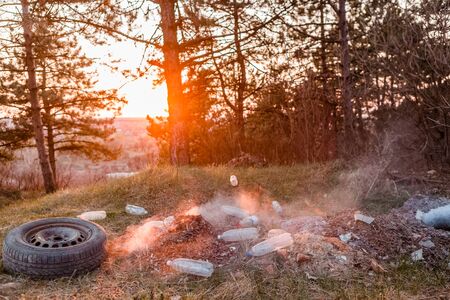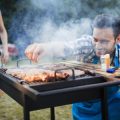1. Choose the Right Cooking Gear
When youre heading out for a camping trip, smart packing is key—especially when it comes to cooking gear. You want tools that can handle more than one task but won’t take up too much room in your pack. The goal is to be efficient without sacrificing the ability to cook satisfying meals at camp.
Go for Versatile and Space-Saving Tools
The best cooking gear for camping is compact, lightweight, and multifunctional. Instead of lugging around a full kitchen setup, stick with essentials that serve multiple purposes. Here are some solid choices:
| Gear | Why It Works |
|---|---|
| Nesting Pots & Pans | Stack together to save space; often come with lids that double as plates or fry pans. |
| Lightweight Stove | Compact and easy to set up; perfect for boiling water or cooking simple meals quickly. |
| Reusable Utensils | Durable and eco-friendly; many sets include fork, spoon, knife, and even chopsticks in one pouch. |
| Collapsible Sink or Bowl | Folds flat when not in use; great for meal prep and cleanup. |
Think Beyond the Campfire
While cooking over a fire sounds fun, it’s not always practical or allowed—especially during dry seasons in some U.S. parks. Having a small gas stove gives you reliable heat wherever you set up camp. Many models run on small propane canisters that are easy to carry and widely available across the U.S.
Pack Smart, Cook Smarter
Your goal should be to bring only what youll really use. Leave behind single-use gadgets like egg separators or garlic presses unless they’re absolutely essential for your meal plan. Stick with items that can handle breakfast, lunch, and dinner without needing backups or extras.
Pro Tip:
A small cutting board and a sharp camping knife can go a long way—theyre light but super useful for everything from slicing fruit to prepping meat or veggies.
Bottom Line:
Packing efficient cooking gear means less stress, easier meals, and more time enjoying the outdoors. Keep it light, keep it useful, and you’ll eat well without overloading your backpack.
2. Plan Meals Before You Pack
One of the easiest ways to cut down on overpacking for campsite cooking is by planning your meals ahead of time. Designing a simple and realistic menu based on your group size and trip duration helps you bring exactly what you need—no more, no less.
Start with the Basics
Before anything goes into your camp kitchen bin, sit down and map out each meal for every day you’ll be at camp. Think about breakfast, lunch, dinner, and snacks. Keep it realistic—this isn’t the time for five-course meals unless that’s part of your plan.
Questions to Ask Yourself:
- How many people are in my group?
- How many meals will we eat at camp?
- Do I have access to a cooler or just dry storage?
- What kind of cooking gear will I actually use?
Sample Menu Plan
A well-thought-out menu helps you avoid packing duplicate ingredients or leaving behind key items. Here’s an example for a weekend trip with four people:
| Meal | Menu | Gear Needed | Main Ingredients |
|---|---|---|---|
| Friday Dinner | Burgers & Chips | Grill or Skillet, Spatula | Burger patties, buns, cheese, chips, ketchup |
| Saturday Breakfast | Pancakes & Bacon | Griddle or Pan, Spatula | Pancake mix, eggs, bacon, syrup, oil |
| Saturday Lunch | Deli Sandwiches & Fruit | Knife, Cutting Board (optional) | Deli meat, bread, cheese slices, apples, mustard |
| Saturday Dinner | Chili & Cornbread | Pots, Spoon, Camp Stove or Fire Grate | Canned beans, ground beef, chili seasoning, cornbread mix |
| Sunday Breakfast | Oatmeal & Coffee | Kettle or Pot, Mugs | Instant oats, coffee grounds or instant coffee, sugar/creamer |
Stick to Multipurpose Ingredients and Tools
A good trick is choosing ingredients that can be used across multiple meals. For example, eggs work for breakfast and can be added to burgers or sandwiches. One skillet might cover all your frying needs. This minimizes both food waste and gear overload.
Pro Tip:
If youre camping with kids or picky eaters, plan meals theyll actually enjoy. Nobody wants to pack food that ends up untouched.
Create a Shopping and Packing List from Your Menu
Once your menu is set, make two lists: one for ingredients and one for cooking tools. Only pack what each meal requires—that way you don’t end up with four spatulas and zero can openers.
Your Packing Workflow Should Look Like This:
- Create your menu based on group size and trip length.
- List the ingredients and quantities needed per meal.
- Note the cookware required for each dish.
- Add only those items to your camp kitchen bin.
This intentional approach helps keep your packing light but complete—so you can focus more on the fun parts of camping instead of digging through cluttered bins looking for that missing spice jar.
![]()
3. Use Space-Saving Storage Solutions
When it comes to campsite cooking, keeping your gear and ingredients organized is just as important as bringing the right stuff. Using space-saving storage solutions can make setting up and breaking down camp much faster—and way less stressful. Here are some simple ways to pack smart and stay organized at your site.
Clear Bins for Easy Visibility
Use clear plastic bins with secure lids to store larger cooking gear like pots, pans, and utensils. The transparency helps you see what’s inside without opening every container. Stackable bins also make loading your vehicle easier and maximize trunk space.
Collapsible Containers Save Space
Collapsible bowls, measuring cups, and food containers are a camper’s best friend. They flatten down when not in use, taking up minimal room in your bin or backpack. They’re perfect for mixing, prepping, and storing leftovers without the bulk.
Labeled Ziploc Bags Keep Ingredients Tidy
Ziploc bags aren’t just for sandwiches—use them to portion out spices, snacks, pancake mix, or chopped veggies before you leave home. Label each bag with a permanent marker so you know exactly whats inside at a glance. This makes meal prep at camp quick and hassle-free.
Packing Suggestions
| Item Type | Storage Solution | Why It Works |
|---|---|---|
| Spices & dry ingredients | Labeled Ziploc bags | Keeps portions controlled and easy to find |
| Pots & pans | Clear plastic bin | Stacks well and gives visual access to contents |
| Bowls & food containers | Collapsible containers | Saves space when not in use |
| Canned goods & utensils | Labeled sections in bin or small crates | Makes unpacking more efficient at camp |
Pro Tip:
Create a “kitchen essentials” bin that stays packed between trips. Include basics like oil, salt, foil, lighter, sponge, and trash bags so you’re never scrambling to remember them again.
4. Prioritize Multi-Use Ingredients
When youre packing for a camping trip, every inch of space counts. One of the easiest ways to pack smarter is to bring ingredients that can be used in multiple meals. Not only does this save room in your cooler or food tote, but it also makes meal planning much easier once youre at the campsite.
Think about versatile staples like tortillas, rice, canned beans, and your favorite spices. These ingredients can be mixed and matched to create different meals without needing a whole pantry of supplies.
Why Multi-Use Ingredients Matter
- Save Space: Fewer unique items means less bulk in your pack.
- Less Waste: Use up what you bring instead of throwing out unused food.
- Flexible Meals: You can adapt recipes depending on what you’re in the mood for.
Top Multi-Use Ingredients for Camping
| Ingredient | Meal Ideas |
|---|---|
| Tortillas | Breakfast burritos, quesadillas, wraps, campfire pizzas |
| Rice | Stir-fry, rice bowls, soups, side dish with grilled meat or veggies |
| Canned Beans | Tacos, chili, bean salad, breakfast hash |
| Spices (e.g., cumin, garlic powder, chili powder) | Add flavor to meats, stews, eggs, and more |
| Cheese (shredded or sliced) | Toppings for burgers, quesadillas, scrambled eggs |
| Eggs | Scrambled eggs, French toast, fried rice, baking mix-ins |
Packing Tip
Pre-portion your dry ingredients like rice and spices into labeled resealable bags. For even more convenience, plan meals ahead of time so you know exactly how much youll need—and avoid carrying extra weight you won’t use.
5. Keep Safety and Clean-Up in Mind
When youre packing for campsite cooking, it’s easy to focus on the fun stuff—like your grill, ingredients, or cast iron skillet—but don’t overlook the essentials that keep your cooking area safe and clean. A tidy camp kitchen not only makes cooking more enjoyable, but it also helps protect wildlife and the environment.
Sanitation Essentials You Shouldn’t Forget
Packing sanitation gear is just as important as packing your meals. Here are a few must-haves to keep everything clean and food-safe:
| Item | Why You Need It |
|---|---|
| Biodegradable Soap | Safe for the environment and effective for cleaning dishes and hands. |
| Trash Bags | Keep your campsite tidy and make it easy to pack out all waste. |
| Disposable or Reusable Gloves | Helpful for handling raw meat or when doing dishes in cold water. |
| Sponge or Scrub Brush | Makes cleaning cookware easier without wasting water. |
| Microfiber Towels | Quick-drying and reusable, great for drying dishes or wiping down surfaces. |
Store Food Securely to Stay Safe from Wildlife
Leaving food out is a big no-no at any campsite. Not only can it attract unwanted animal visitors like raccoons or bears, but it also creates a safety hazard for you and other campers. Here’s how to store food properly:
- Use Bear-Resistant Containers: Especially if youre camping in bear country, these are a must.
- Coolers with Locking Lids: Keeps both animals and bugs out of your perishables.
- Hang Food When Necessary: If there are no lockers available, hang your food at least 10 feet off the ground and 4 feet away from tree trunks.
- Avoid Keeping Food in Your Tent: Always store food outside of sleeping areas to avoid nighttime surprises.
Quick Clean-Up Tips After Each Meal
- Scrape Plates First: Get rid of leftover bits before washing to reduce mess.
- Use Minimal Water: Rinse with a small amount of water; collect gray water and dispose of it at designated dump stations.
- Tidy Up Immediately: Don’t wait until later—clean up right after meals to keep pests away.
Packing efficiently means thinking ahead about both safety and cleanliness. With the right gear and habits, you’ll enjoy stress-free campsite cooking while being a responsible camper who leaves no trace behind.


